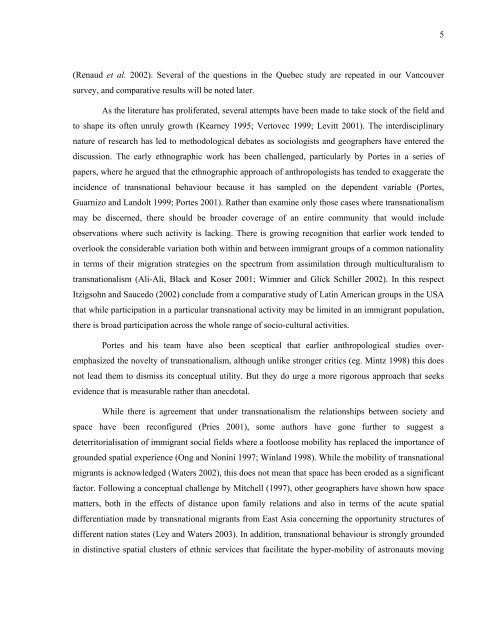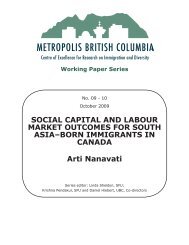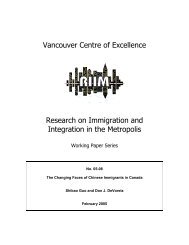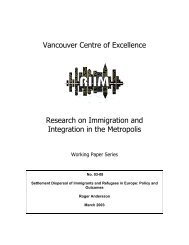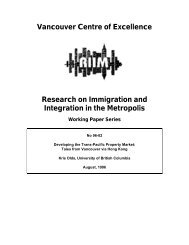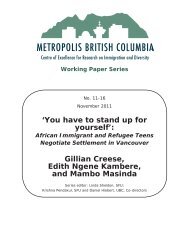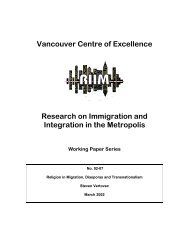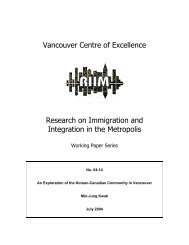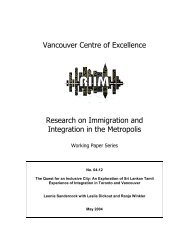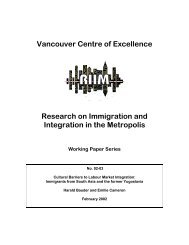Characteristics of Immigrant Transnationalism in ... - Metropolis BC
Characteristics of Immigrant Transnationalism in ... - Metropolis BC
Characteristics of Immigrant Transnationalism in ... - Metropolis BC
You also want an ePaper? Increase the reach of your titles
YUMPU automatically turns print PDFs into web optimized ePapers that Google loves.
5<br />
(Renaud et al. 2002). Several <strong>of</strong> the questions <strong>in</strong> the Quebec study are repeated <strong>in</strong> our Vancouver<br />
survey, and comparative results will be noted later.<br />
As the literature has proliferated, several attempts have been made to take stock <strong>of</strong> the field and<br />
to shape its <strong>of</strong>ten unruly growth (Kearney 1995; Vertovec 1999; Levitt 2001). The <strong>in</strong>terdiscipl<strong>in</strong>ary<br />
nature <strong>of</strong> research has led to methodological debates as sociologists and geographers have entered the<br />
discussion. The early ethnographic work has been challenged, particularly by Portes <strong>in</strong> a series <strong>of</strong><br />
papers, where he argued that the ethnographic approach <strong>of</strong> anthropologists has tended to exaggerate the<br />
<strong>in</strong>cidence <strong>of</strong> transnational behaviour because it has sampled on the dependent variable (Portes,<br />
Guarnizo and Landolt 1999; Portes 2001). Rather than exam<strong>in</strong>e only those cases where transnationalism<br />
may be discerned, there should be broader coverage <strong>of</strong> an entire community that would <strong>in</strong>clude<br />
observations where such activity is lack<strong>in</strong>g. There is grow<strong>in</strong>g recognition that earlier work tended to<br />
overlook the considerable variation both with<strong>in</strong> and between immigrant groups <strong>of</strong> a common nationality<br />
<strong>in</strong> terms <strong>of</strong> their migration strategies on the spectrum from assimilation through multiculturalism to<br />
transnationalism (Ali-Ali, Black and Koser 2001; Wimmer and Glick Schiller 2002). In this respect<br />
Itzigsohn and Saucedo (2002) conclude from a comparative study <strong>of</strong> Lat<strong>in</strong> American groups <strong>in</strong> the USA<br />
that while participation <strong>in</strong> a particular transnational activity may be limited <strong>in</strong> an immigrant population,<br />
there is broad participation across the whole range <strong>of</strong> socio-cultural activities.<br />
Portes and his team have also been sceptical that earlier anthropological studies overemphasized<br />
the novelty <strong>of</strong> transnationalism, although unlike stronger critics (eg. M<strong>in</strong>tz 1998) this does<br />
not lead them to dismiss its conceptual utility. But they do urge a more rigorous approach that seeks<br />
evidence that is measurable rather than anecdotal.<br />
While there is agreement that under transnationalism the relationships between society and<br />
space have been reconfigured (Pries 2001), some authors have gone further to suggest a<br />
deterritorialisation <strong>of</strong> immigrant social fields where a footloose mobility has replaced the importance <strong>of</strong><br />
grounded spatial experience (Ong and Non<strong>in</strong>i 1997; W<strong>in</strong>land 1998). While the mobility <strong>of</strong> transnational<br />
migrants is acknowledged (Waters 2002), this does not mean that space has been eroded as a significant<br />
factor. Follow<strong>in</strong>g a conceptual challenge by Mitchell (1997), other geographers have shown how space<br />
matters, both <strong>in</strong> the effects <strong>of</strong> distance upon family relations and also <strong>in</strong> terms <strong>of</strong> the acute spatial<br />
differentiation made by transnational migrants from East Asia concern<strong>in</strong>g the opportunity structures <strong>of</strong><br />
different nation states (Ley and Waters 2003). In addition, transnational behaviour is strongly grounded<br />
<strong>in</strong> dist<strong>in</strong>ctive spatial clusters <strong>of</strong> ethnic services that facilitate the hyper-mobility <strong>of</strong> astronauts mov<strong>in</strong>g


